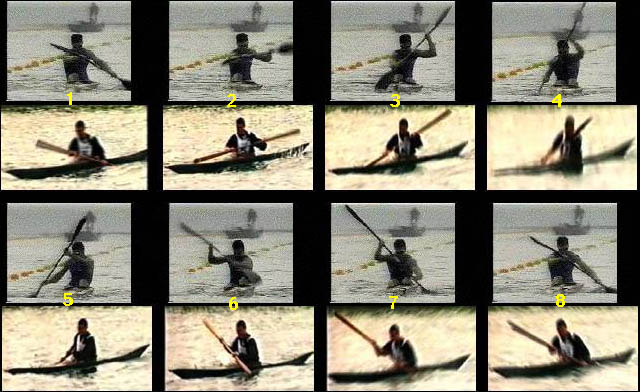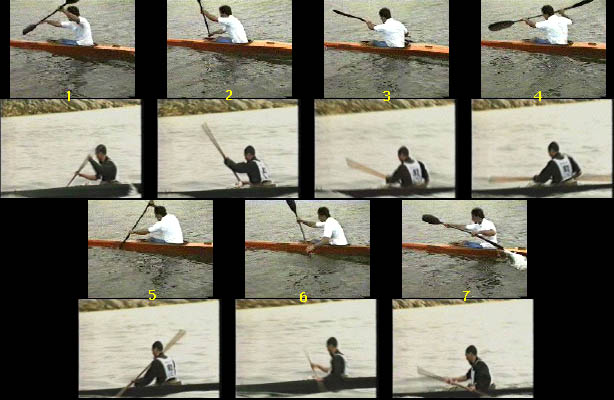Looking at masters, it is hard to learn because they seem flawless. Dissecting their behaviors and movements and comparing notes would be just as good as learning from master.
I see lots of different movements in efficient stroke;
hip twist
leg push and pull
stomach crunch
straight arms (This is a lot like rock climbing)
gentle introduction of paddle into water
meeting the water sweet spot
rotation of body to crank big muscles into gear
cadence
development of speed
speedy exit of paddle
relaxed and paced stroke for endurance
There are many variables;
type of paddle; wing, euro, greenland
type of hull; hard, soft, and shape
Unlike flatwater paddling, paddling with waves takes mindfullness; this is where my yoga comes in handy. :-)
Go and be one with water and waves..
The catch is that there are many variables. By the time, we have clinic and you can contribute better understanding of how these variables play. So study and practice your strokes. Ask away at the clinic.
For those who are armchair kayaking, here is a reading material written by our guruji, Joe Glickman. I read pages and it is a great fun book. I know I am putting Joe on pedestal. Enjoy it.
Meanwhile, see these videos and more reading materials;http://www.amazon.com/Kayak-Companion-Joe-Glickman/dp/158017485X/ref=sr_1_2/105-0593803-1050000?ie=UTF8&s=books&qid=1188482619&sr=1-2
http://www.qajaqusa.org/Movies/movies.html
http://en.kayakwiki.org/index.php/Forward_stroke
http://www.kayakforum.com/Albums/Front_Comparison.jpg
This picture compares wing paddle and greenland. You see surf ski switching and extending legs transmitting power from leg over to shoulder. Green lander enters his paddle closer and takes shorter stroke. He does little stomach crunches and shoves the boat.
http://www.kayakforum.com/Albums/Stroke_Comparison.jpg
This picture shows side view.
Here are some excerpts;
"Below is a comparison of a wing paddle forward stroke and the Greenland forward stroke. These are not completely comparable strokes as the Greenland paddle is doing a long distance race, and the wing paddle is sprinting.
http://www.kayakforum.com/Albums/Front_Comparison.jpg
The most noticable difference is the wing paddler slices his paddle out to the side in the water (Flared Stroke) where the Greenland paddler appears to pull more straight back. The Greenland paddle pushes the upper hand down across the boat, where the wing paddler pushes the upper hand horizontally across at eye level. In both cases the stroke starts out with the upper hand at nearly eye level.
http://www.kayakforum.com/Albums/Stroke_Comparison.jpg
Here you can see that both paddlers use significant torso rotation. It is quite noticable that the wing paddle crosses over the boat with his hands held high, and the Greenland paddler crosses over with hands held low.
Some of these differences may be attributed to the different kind of paddling they are doing. As you increase your stroke rate it helps to have a more vertical stroke. I have found that having the upper hand cross the centre line of the kayak at the beginning of the stroke keeps the blade in a more vertical position and forces good torso rotation. This is virtually the only cause of paddle movement, arm movement being restricted to giuding the paddle out from the boat (or rather allowing the paddle to find its own optimum direction through the water). For longer distance paddling, it is helpful to have a more horizontal stroke. Varying between sometimes more vertical and sometimes more horizontal allows better muscle recovery for longer distance trips. Also note the differences in paddle size and shape. This influences the path the paddle takes through the water and which position is most efficient."
Philippe Castagner sent an interesting article which was forwarded to me about greenland paddle. There are multiple sources of this paddling techniques not just from Maligiaq. It goes to tell you wing paddle might be inspired by greenland. For long distance paddling (> 20 miles), one could develop a different type of paddle.
http://www.qajaqusa.org/Technique/Greenland_technique_from_the_source.html
In this instance, greenland paddle acts like wing paddle; bit of bracing and getting ready for the sweet spot.
Power Phase. Maligiaq does not display as much side-to-side torso rotation as compared to an experienced paddler using the recreational stroke. Instead his pushing hand starts from just below the tip of his shoulder and is levered downward toward the deck, crossing just over the centerline of the kayak. His spine rises slightly and drops down in concert with his arm motion. His elbows stay fairly close to his sides. Viewed from the back, he looks like a boxer making slow motion, downward punches on alternating sides of his foredeck. Maligiaq's paddle shaft was held at approximately a 45-degree angle for normal cruising, higher than the paddles of the surrounding students and instructors (Note - this is the angle between the paddle shaft and the horizon, please don't confuse this shaft angle with the forward tilt of the blade discussed earlier).




2 comments:
Like that Amazon marketing thing -
Readers who liked this post may also like the Of Paddles & Planes series on Frogma.
I was going on a bit after that first Greenland forward stroke lesson. It's just so antithetical to the Euro stroke!
What confounds me is how slouchy some of the best paddlers seem to be. Like very fast chickens... That tells me slouching is something you really have to watch because it will not necessarily hold you back to slouch. Does anyone have info on how posture and power are related? i would imagine the longer the spine, the more room there is to breathe, rotate, etc...
Position of the head and neck is still a big mystery to me.
Post a Comment